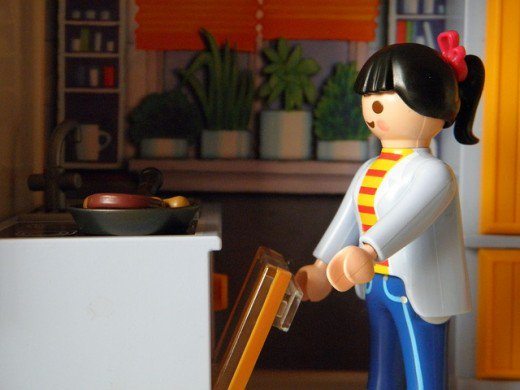Children Learn Quickly: a Short Lesson in Neuroplasticity
Children’s Development: Children are extremely fast learners. For newborns, the world is a flood of information and they absorb it like a sponge.

Cortical neuron stained with antibody to neurofilament subunit NF-L in green. In red are neuronal stem cells stained with antibody to alpha-internexin. | Source
Connections between neurons in the brain called ‘synapses’ form, and because children have the ability to take in large amounts of information, the number of connections in a young child’s brain (particularly babies and toddlers) are far greater than an adult’s.
Unlike adult brains which ignore irrelevant information, the developing brain takes in everything, and forms neural connections that are virtually useless. As the child develops, certain synapses which are used more and more are strengthened and become more efficient.
This is due to a phenomenon called neuroplasticity, which is the ability of the brain to change; something which is particularly active during early years but still occurs well in to old age.
As children get older, neural connections which are not used weaken and may eventually be discarded altogether in a process called ‘synaptic pruning’. Essentially, the brain is a “use it or lose it” system.
Children go through sensitive learning periods, or ‘critical periods’, in which they are particularly sensitive to certain information. For example, humans have a critical period for vision, in which newborns take in a huge amount of visual information during the first few months.
This is essential during children’s development of an efficient visual system. Some infants born with cataracts receive corrective surgery far too late – years after their birth – and as a result never properly develop their visual system because the critical learning period has already ended.
Early corrective surgery can ensure normal development. In the same way, humans also have a critical period for language development, which stretches from birth to around the age of 12.
This is why young children are so much better at learning languages and musical instruments than adults, and why it’s a good idea to promote the development of language and musical skills early.
Some skills and systems require development in their respective critical learning period(s), others can be learned later in life. But generally speaking, it is far “easier” to do so at a young age.
Children Are Impressionable
Children are also extremely impressionable because of their heightened ability to take in information. Early experiences have a significant impact on Children’s Development, both cognitive and social.
Thus, realising the potential of the sensitive learning period is important to maximise the development of children’s cognitive skills. Increasing exposure to learning early in a child’s life can be accomplished even through choosing toys which promote development of cognitive skills.
Children are not only able to learn skills early on, but they can recognise and internalise social cues from their environment. Adults therefore have a responsibility to ensure that children’s potential to be influenced is used for good and not evil, and to prevent any internalising of harmful information like prejudices and oppressive stereotypes.
Toys and Stereotypes Influence Children’s Development
Considering the amount of time children spend playing with toys, it seems strange that so little attention has been drawn to their contribution to Children’s Development.
It is even more surprising that the apparent disparity between girls’ and boys’ cognitive abilities in later years lasting into adulthood, especially concerning boys’ average higher aptitude for spatial and mathematical tasks or girls’ talent for empathy and language, has not been linked to the dualistic, gendered nature of children’s toys and the media.
Children Develop Their Gender Identities At Around Age Two
From the moment we’re born we’re inundated with social conditioning that teaches us that we live in a dualistic world; one with a ying and yang; a masculine and feminine; men and women.
We paint bedroom walls pink for girls and blue for boys, we buy frilly dresses for girls and superhero t shirts for boys. Girls are complimented on how pretty their hair is while boys are complimented for their bravery and confidence.
But even if you can escape any social conditioning from these early influences of parents and family, there’s always the constant inundation of advertisements promoting dolls for girls and monster trucks for boys, and the gender stereotyping in TV shows, movies and games.
Young children are impressionable, and they can take in social cues from parents, peers, teachers, and the media from a very young age. They learn that boys and girls are different, and that they wear different clothes and act differently and play with different toys.
Children themselves are also able to reinforce these gender distinctions by teasing siblings and classmates who deviate from gender-specific boundaries. This is a defensive tactic children employ in order to identify with a group (i.e. their sex) which gives them an important sense of belonging and fulfils the human desire to ‘fit in’.
These influences not only shape what children want but they also teach children what society expects them to want.
Toy Companies Exploit Gender Stereotypes
Toy companies want to make a profit. The truth is that it is much more profitable for toy companies to create separate markets for boys and for girls, each requiring their own, separate products, rather than making products that appeal to boys and girls both.
By reinforcing the idea of gendered colours, personality traits, clothes, and even careers, toy companies create a pressure for children to ‘fit in’ with their genders, for fear of ridicule and social isolation if they do not.
Suddenly, and unsurprisingly, children start to place an intense interest in defining and separating genders, and in conforming to these expectations.
Thus we see more and more extreme versions of masculine and feminine children’s toys being created and being accepted by children, who certainly don’t have the power to properly consider these social pressures and/or resist them.
We get those separate pink and blue isles in toy stores, separate clothing designs and different shoes, and suddenly even our doona covers become something that needs to be gendered.
Scientific Studies on Children’s Toys:
A recent study in 2005 by Blakemore & Centers involving using a number of undergraduates to provide ratings for certain children’s toys supports many of these findings.
Undergraduates rated toys as to how ‘masculine’ or ‘feminine’ they were. They then rated each toy for a number of other characteristics. Blakemore & Centers found that more toys previously thought of as being ‘masculine’ were now rated closer towards neutral (like blocks and legos), however they conclude that toys for the most part are usually able to be classed as being associated with one gender or the other.
They found:
- Feminine toys were more likely to be associated with encouraging appearance and attractiveness than masculine toys, and were also rated as being more visually attractive.
- The more feminine a toy was rated, the higher it was also rated in encouraging nurturance and domestic skills.
- Masculine toys were rated as more aggressive, competitive, violent, sustaining of attention, exciting, fun, dangerous & risky, and in need of adult supervision, than feminine toys. The toys themselves were also more likely to move on their own than girls’ toys.
- Neutral and masculine toys tended to be more responsive to the child’s input, and were more likely to encourage the development of spatial, scientific and intellectual skills, than feminine toys.
It is important to note that these ratings were provided by undergraduate students, and does not necessarily reflect children’s actual behaviour (Click here to read the full study).
Unfortunately, and surprisingly, little study has been done on children themselves, to determine to what extent toys can influence their behaviour and cognitive development.
Most research on the effects of toys investigates the contribution of video games in promoting violence, and the effects of toys like guns and action figures that can lead to an increase in aggressive play (Goldstein (1995), Hellendoorn & Harinck (1997), Watson & Peng (1992)). However it has also been shown that video games can actually improve cognitive and spatial skills ((De Lisi & Wolford (2002), Green and Bavelier (2003), Greenfield, deWinstanley, Kilpatrick and Kaye (1996)).
Society’s Impact on Children’s Development, Social and Cognitive
Feminine toys tend to encourage nurturing and domestic skills, and emphasise the importance of attractiveness and appearance.
Disturbingly, feminine toys can over-emphasise the importance of attractiveness and can lead to the oppressive ideal that a woman’s worth is appearance-based, particularly to a greater extent than men.
It is unsurprising, then, that eating disorders are much more prevalent in women than in men.
If girls spend hours playing with toys like toy babies and barbies, they will undoubtedly begin to develop a sense of nurturing and empathy.
Conversely, boys who avoid playing with dolls for fear of ridicule don’t have as much of an opportunity to develop these traits. Similarly, when girls play with toy kitchens they can begin to develop skills in domestic duties, and to become more accepting towards them.
Boys who are less likely to play with these sorts of toys will undeniably be less accepting and interested in these tasks. Even in the eyes of young children, being nurturing, child-rearing, and completing domestic duties begin to become associated with girls; with being feminine; and in later life, with being a woman (click here for a study exploring the impact of dolls on attitude of nurturing and childbearing). These oppressive ideals of nurturing and domestic duties being associated with women is perpetuated.
In the same way, if boys spend hours upon hours playing with legos and blocks, they will obviously develop their spatial skills. The disparity between boy’s and girl’s cognitive abilities in schools is therefore very unsurprising.
Furthermore, because of the idea that men are naturally better at spatial, mathematical and scientific tasks is so pervasive in society, teachers can subconsciously expect boys to be better at maths and not encourage girls to participate as much.
If female students themselves expect that they won’t be as proficient as the boys and have less interest in scientific pursuit, it can create a self-fulfilling prophecy in that because they are less interested, they will practice these skills less.
This lack of practice means that they will perform even worse, which will further decrease their interest and so on, and the disparity between boys and girls’ scientific and mathematical abilities will widen (click here for a good article on how stereotypes can effect scholastic performance, and the role of teachers’ subconscious stereotypes affecting children).
The general higher aptitude for mathematical/scientific and spatial tasks in adult men compared to women can be explained with reasons other than there being an innate biological factor.
Boy Playing with LEGO | Bricks 4 Kidz Program
Practice makes perfect, and the more experience people have in a particular area, the more proficient they become. If girls play with feminine toys more than boys, of course they will become more nurturing and empathetic. In the same way, if boys spend hours playing with blocks, of course they will be better at spatial skills.
Over-exposure to ‘masculine’ toys can encourage the development of spatial, scientific and intellectual skills, but hyper-masculine toys can promote violent, risky, and competitive behaviour.
This may cause boys to place a subconscious importance in these traits, and for society to learn to accept and associate these traits with men. This may explain why men participate in more risk-taking behaviour than women and why it is more socially acceptable for boys and men to be dominant, aggressive and violent.
I want to note that these social influences do not rule out an inherent biological difference between genders. Such is still entirely possible, and it is unlikely that biological differences between sexes has no cognitive influence whatsoever.
It is evident that these differences are influenced significantly by social factors, and that gendered toys contribute to these differences.
How to Optimise Your Child’s Development
Not that one barbie doll will turn your daughter into a 50’s-style housewife and one toy truck will turn your son into an aggressive criminal, it is that cumulatively, over years of being exposed to media and socially generated gender-stereotypes, girls and boys can develop one-sidedly.
By which I mean; children may miss out on the advantages offered by their opposite-gender toys, if they grow up only playing with toys appealing to their biological sex.
Furthermore, hyper-masculine and hyper-feminine toys tend to lead to disadvantages like promoting an importance in image for women and promoting aggression in men.
More neutral, less gendered toys like blocks and musical instruments tend to promote artistic, creative, social, educational and scientific development to a greater extent than hyper-feminine and hyper-masculine toys.
Here are some tips for creating a less stereotyped environment and for expanding your child’s potential for cognitive development:
- Encourage your child to use a range of toys. Gender-specific toys offer different advantages so it’s important that they use a range of toys to get a well-rounded experience and development.
- Communicate! It is indubitable that children will take in stereotypes – there is nothing you can do to outright prevent it. Therefore it is important that you keep communicating with them and challenging these concepts, and ensuring that they are not internalising harmful stereotypes.
- Include ‘neutral’ toys. The most benefits seem to come from playing with moderately gendered and neutral toys, which rate highest in encouraging development of cognitive, scientific, musical and artistic skills. Some ‘neutral’ toys include play-doh, legos and other building blocks, puzzles and musical instruments like xylophones.
- Limit exposure to stereotype-reinforcing media. Try taping shows and fast-forwarding through the commercials.
- Watch your language around your children. We often don’t realise how our language can often contain subtle conditioning. Praising girls for looking pretty while never doing so for boys can reinforce the idea that a girl’s/woman’s worth is appearance-based. Offer praise, but make sure it’s fair and that it encourages all virtues and not just the ones stereotyped for one gender.
- Try to include TV shows, movies and games that are less likely to reinforce gender stereotypes. This requires a very critical eye and it’s pretty unlikely that you’re going to find things with no inherent conditioning, but it’s important to give your child a range of choices. Make sure you include movies with strong female roles and which allow don’t just outright punish male femininity. Furthermore, try to reduce exposure to violent or aggressive media.









